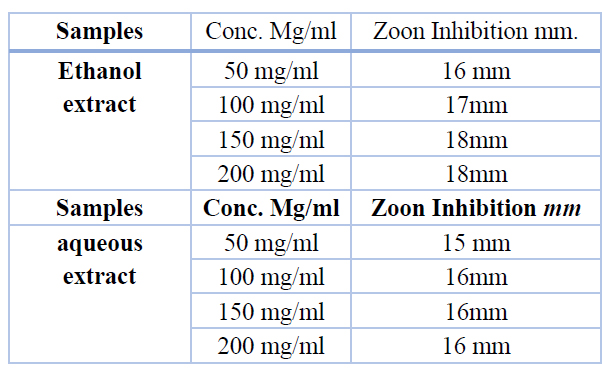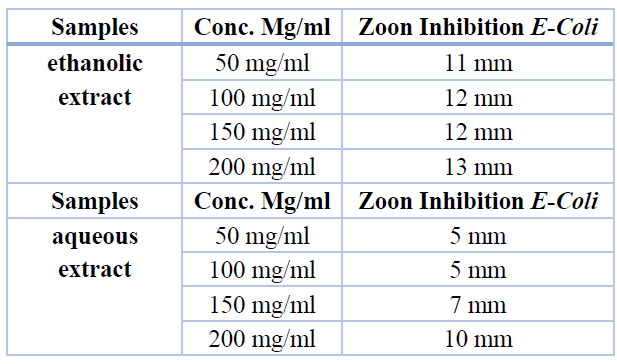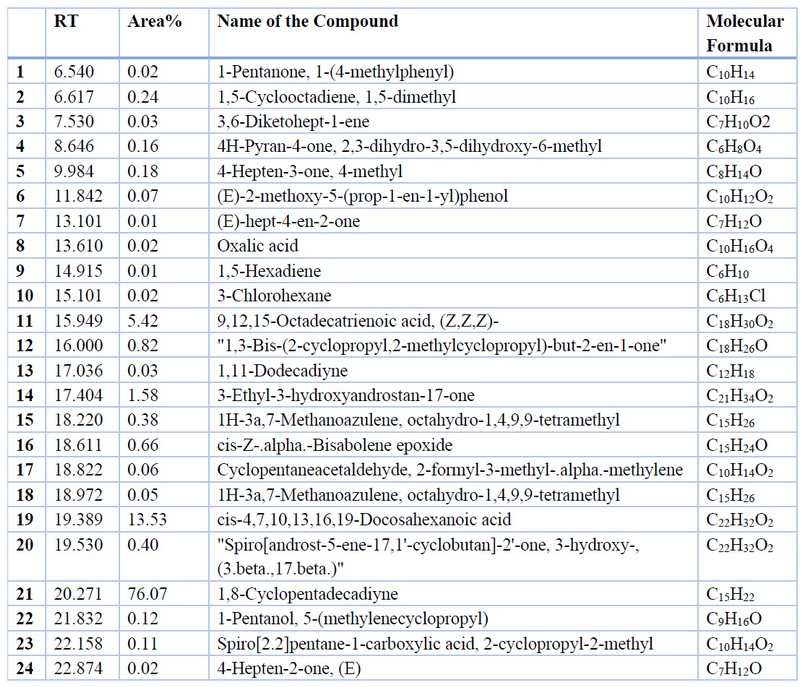2022.07.02.33
Files > Volume 7 > Vol 7 No 2 2022
1Department of Biotechnology, College of Applied Science, Al-Fallujah University, Al-Anbar, Iraq
2Department of Biology, College of Science, Al-Anbar University, Al-Anbar, Iraq
* Correspondence:e-mail; [email protected],
Available from: http://dx.doi.org/10.21931/RB/2022.07.02.33
ABSTRACT
Traditionally, numerous components of medicinal plants, such as their roots, stems, flowers, fruits, and twigs, were widely employed as crude extracts to treat many human ailments. This investigation aimed to look at the effectiveness of various antimicrobial agents of Saussurea costus against G+ve bacteria Streptococcus penumoniae and G-ve bacteria Escherichia coli. The antibacterial activity of the plant was determined using the diffusion technique, which was used to both alcoholic and aqueous extracts generated from the plant's roots against streptococcus penumoniae and Escherichia coli; the inhibition zone was measured by millimeter. The antimicrobial examination revealed that the Gram-positive bacteria represented by Streptococcus penumoniae were susceptible to the alcoholic extracts of S. costus with inhibition zones (18 mm) at 200 mg/ml concentration. In contrast, the aqueous extract had fewer inhibition zones (16 mm) at a 200 mg/ml concentration. Meanwhile, E.coli had a weak effect on the alcoholic extracts with inhibition zones (13 mm) at 200 mg/ml concentration. Still, aqueous extract was (10 mm) at200 mg/ml concentration. The constituents of the ethanolic extract of roots were investigated using Gas chromatography-mass (GC); twenty-four compounds were identified in the extract of the roots, such as C10H14 and C10H16. The results demonstrated that the Saussurea costus extracts have antimicrobial activity against Gram-positive bacteria S. pneumoniae while it has a weak effect against E.coli
Keywords Saussurea costus. Antimicrobial. Ethanolic extract. Streptococcus penumoniae. Escherichia coli
INTRODUCTION
Plants have long been recognized as a significant source of natural compounds for the maintenance of human health, particularly in developing countries. This has been even truer in recent years as more thorough research into natural medicines has been done, notably in the past decade 1. Studies of natural products derived from various sources, notably higher plants, have piqued researchers' interest in discovering new antimicrobial and antioxidant agents. These antimicrobial agents include compounds such as tannins and alkaloids and terpenoids and flavonoids, which have been proven to exhibit antibacterial activities in vitro and in vivo, respectively 2. Saussurea costus (also known as Saussurea lappa) is a member of the Asteraceae family, which is widely spread around the world; however, a large number of species are found in India, Pakistan, and some sections of the Himalayas, where it is known as the "Indian Aster" 3. The therapeutic effects of S. costus have been thoroughly documented in several medical systems. Many cultures have employed the aromatic roots of Saussurea costus, as medicines, incense, and ointments for thousands of years4. This research aimed to determine the antibacterial activity of extracts against different pathogenic bacteria in vitro represented by Escherichia coli and Streptococcus penumoniae.
MATERIALS AND METHODS
Sample Collection
The dried roots of S. costus were purchased at a herbal market and were later recognized by a taxonomist at the Desert Studies Center at the University of Anbar in Iraq.
Aqueous Extract Preparation
The plant's roots were washed "for 2-3 times with tap water, then dried significantly, using an electrical grinder, the root was crushed into small particles and subsequently fine powder. The powder of dried roots was 25 gm mixed with 250 ml of solvent (water) for 24 hours; after that, the mixtures were filtered by gauze and centrifuged at 3000 rpm for 15 minutes and then dried in a hot air oven at 45 ° C for 48 hrs. The dried extract was kept in a sterile container until used 5.
Alcoholic Extract Preparation
The roots of the plant (25g) were crushed and soaked with 90% ethanol, and the mixture was homogenized in magnetic stirrers; after that, crude was filtered twice by gauze. The filtrate was concentrated on a rotary evaporator at 45ºC 6.
Antimicrobial activity
The antimicrobial activity of the extract was performed by the diffusion method. The selected bacterial isolates streptococcus penumoniae and escherichia coli were activated on nutrient broth and incubated for 24 hours at 37°C. Holes were made on mueller- hinton by using a 6 mm cork borer. Each hole was filled with extracts. Antibacterial activity was evaluated by measuring the area of inhibition zone 7. The chromatograph utilized at the Iraqi Ministry of Sciences and Technology was a Shimadzu GC-2010 plus-Japan, which was purchased in Japan. The gas chromatography-mass spectrometry (GC-MS) system is an extremely significant tool for the study of bioactive chemical substances: ZB-5MS is the Capillary column number (30 m x 0.25 mm, ID 0.25 μm), Carrier Gas: UHP Helium, Injection Temperature: 280.00˚C, Detector Temperature: 280.00 °C, Injection Mode: Split, Flow Control Mode: Pressure, Injector Pressure: 100.0 kPa, Total Flow: 47.3 μl/min, Column Flow: 1.43 μl/min, Linear Velocity: 44.1 cm/min, Injection Volume: 1 μL, Run Time: 35 minutes. A freshly prepared sample (10mg/ml) was used.
RESULTS
The results showed that S. pneumoniae (Table1) showed a sensitivity to the alcoholic extract, with the highest inhibition zone (18 mm) at 200 mg/ml concentration and the lowest inhibition zone being 16 mm at 50 mg/ml concentration. At the same time, the aqueous extract showed a sensitivity of S. pneumonia to the extract (16 mm) at a 200 mg/ml concentration. The lowest rate of inhibition zone was 15 mm at a concentration of 50 mg/ml.

Table 1. Inhibition zone of the alcoholic and aqueous extract against s. pneumoniae
Concerning that E.coli,( Table 2 below) (ethanolic extracts) showed the highest inhibition zone was (13 mm) at 200 mg/ml, while aqueous extracts of S. costus showed 10 mm at 200 mg/ml, which means that E.coli has weak susceptible to the extracts.

Table 2. Inhibition zone of the alcoholic and aqueous extract against E.coli
After a GC-analysis evaluation, Saussurea costus roots have been shown to be a rich source of numerous bioactive elements, which identified twenty-four biochemical substances in the roots. Table 3 shows the results of a compound analysis of an ethanolic extract of S.Costus.

Table 3. Identification of biochemical compounds by GC-M S
DISCUSSION
High-quality plant extracts with antibacterial properties have recently piqued researchers' curiosity, and various phytochemicals, such as the antimicrobial actions of several plant species, have been extensively studied. Examples of antimicrobial capabilities include the crude extracts of herbs such as cinnamon and garlic; basil and curry; ginger; sage; mustard; and other herbs. These plants also have a killing role to word various microorganisms 8. In the current study, the results are shown in Table (1) indicated that the zone inhibition of streptococcus pneumoniae at the lowest concentration 50 mg/ml was (15 mm), increased by increasing the concentration of the alcoholic and aqueous extract, which indicates a direct relationship between the concentrations of the extracts and the rates of the zone of inhibition. The ethanolic extracts offered somewhat good antimicrobial activity compared with aqueous extracts; there may be some active substances soluble in alcohol and insoluble in water, where the active substances released are more. It is commonly known that ethanol at 90% concentration can have several components more effectively than at lower concentrations. The results showed that Gram-positive bacteria were more sensitive to the antibacterial activity of ethanolic extracts and aqueous extracts of S. costus roots. This may be attributed to the fact that the "cell wall in Gram-positive bacteria consists of a single layer, whereas Gram-negative cell wall is a multilayered structure" bounded by an outer cell membrane 9. There has been a plethora of research undertaken using plant extracts to screen for antimicrobial activity and the identification of novel antimicrobial chemicals, all of which have proven beneficial. When tested against all serogroups of E. coli at (100 % concentration), garlic extract shown high antibacterial activity owing to the action of allicin, diallyl thiosulphinic acid, or diallyl disulfide, among other active ingredients 11. On the other hand, the earlier research has looked at several ways and chemicals that may be utilized to suppress pathogenic bacteria, such as the direct impact of nanoparticles on pathogenic microorganisms such as Proteus spp 12. Also, several studies have shown that applying physical forces to dangerous bacteria, such as Audible Sounds and Magnetic Fields, may help to reduce infection resistance13.
CONCLUSION
From the data presented above, we can deduce that Saussurea costus extracts have antibacterial activity against Gram-positive bacteria such as S. pneumoniae but only a mild effect on E.coli.
Funding: Funded by self.
Acknowledgments: Thanks to all who support us.
Conflicts of Interest: None
REFERENCES
1. Nascimento G G, Locatelli J , Freitas P C, and Silva G L. Antibacterial activity of plant extracts and phytochemicals on antibiotic-resistant bacteria. Brazilian journal of microbiology.(2000): 31, 247-256.
2. Habbal O A, Al-Jabri A A and El-Hag A G. Antimicrobial properties of Lawsoniainermis(henna): a review. Aust J Med Her .(2007); 19: 114-125.
3. Saif-Al-Islam M. Saussurea costus may help in the treatment of COVID-19. Sohag Medical Journal.(2020): 24(3).7-17.
4. Julianti T. Discovery of natural antiprotozoals from medicinal plants Saussurea costus and Carica papaya (Doctoral dissertation.(2014).University of Basel..
5. Hernandez M, Lopez R A, Dorias R M and Arias A. Antimicrobial activity of Visnea mocanera leaf extracts .J. Ethnopharmacology(1994): 41 : 102-109.
6. Randhir R, Lin Y T, Shetty K. Phenolic, their antioxidant and antimicrobial activity in dark germinated fenugreek sprouts in response to peptide and phytochemical elicitors. Asian Pac J Clin Nutr 2004; 13: 295-307.
7. Fisgin N T, Cayci Y T, Coban A Y, Ozatli D, Tanyel E , Durupinar B and Tulek N. Antimicrobial activity of plant extract Ankaferd Blood Stopper®. Fitoterapia(2009):80(1), 48-50.
8. Castro S B R, Leal C A, Freire F R , Carvalho D A, Oliveira D F, and Figueiredo H C P. Antibacterial activity of plant extracts from Brazil against fish pathogenic bacteria. Braz. J. Microbiol. 2008: 39, 756–760.
9. Yao J, Moellering R. Antibacterial Agents: Manual of Clinical Microbiology. ASM: Washington DC.(1995).pp. 1281–1290.
10. Zakaria Z, Sreenivasan S and Mohamad M. Antimicrobial Activity of Piper ribesoides Root Extract against Staphylococcus aureus. J. App. Biol. Sci, 2007; 1(3): 87-9.
11. Indu M N, Hatha A A M, Abirosh C, Harsha U and Vivekanandan G. Antimicrobial activity of some of the south-Indian spices against serotypes of Escherichia coli, Salmonella, Listeria monocytogenes and Aeromonas hydrophila. Braz. J. Microbiol. (2006); 37: 153-158.
12. Saleh TH, Hashim ST, Malik SN, AL-Rubaii BAL. DownRegulation of full gene expression by Ag nanoparticles andTiO2 nanoparticles in pragmatic clinical isolates of Proteus mirabilis and Proteus vulgaris from urinary tract infection. Nano Biomed Eng.2019; 11(4):321-332.
13. Ali MAM and Al-Rubaii BAL. Study of the Effects of Audible Sounds and Magnetic Fields on Staphylococcus aureus Methicillin Resistance and mecA Gene Expression. Trop J Nat Prod Res. 2021; 5(5):825-830.
Received: 14 January 2022 / Accepted: 28 February 2022 / Published:15 May 2022
Citation. Azeez Akoul M, Ghreeb M. Antimicrobial Activity of Saussurea costus Extracts Against Streptococcus penumoniae and Escherichia coli. Revis Bionatura 2022;7(2) 33. http://dx.doi.org/10.21931/RB/2022.07.02.33
